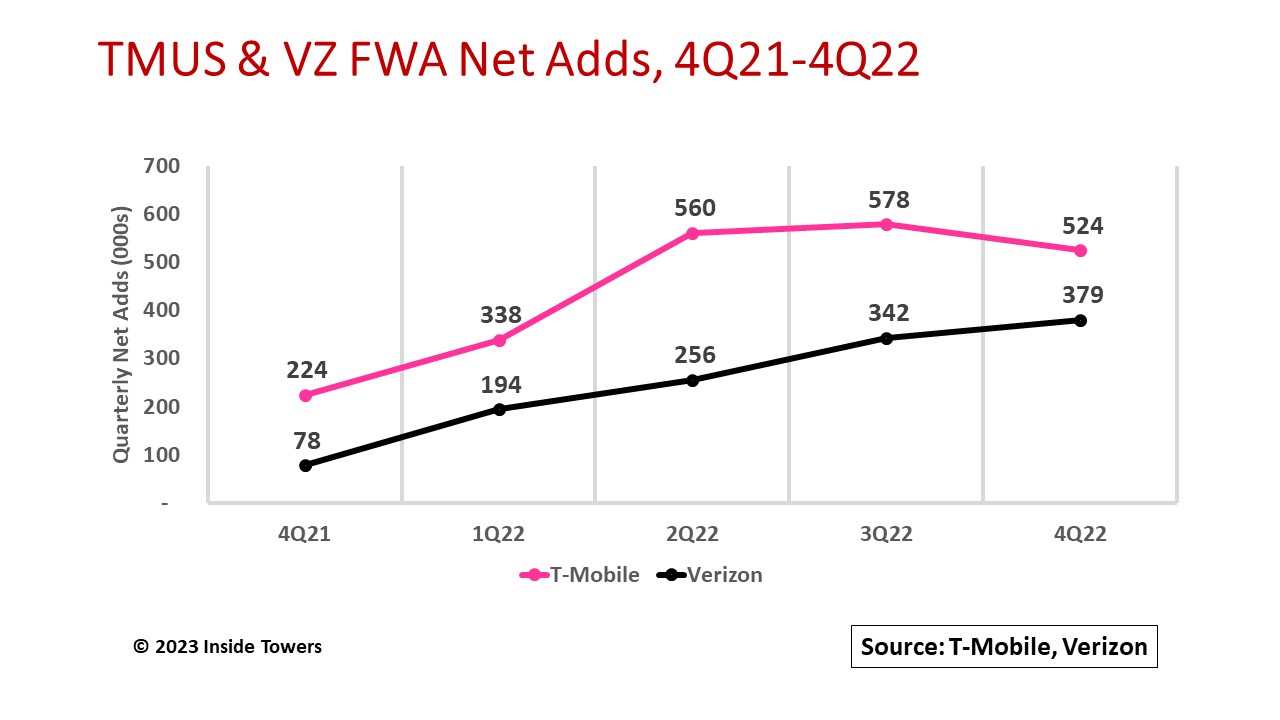Fixed wireless access is a fast-growing broadband segment. T-Mobile (NASDAQ: TMUS) added two million postpaid and prepaid broadband customers with its 5G Home Internet service to reach over 2.6 million at the end of 2022. Similarly, Verizon Wireless (NYSE: VZ) added one million and reported a total of 1.4 million consumer and business FWA broadband customers at year-end. Together, the two MNOs outpaced fiber and cable companies in broadband net adds for the year. In context, though, FWA represents just two percent of T-Mobile’s 113.6 million retail mobile customers at year-end 2022, and one percent of Verizon’s 143.3 million.
Despite a fast start early in the year, T-Mobile’s FWA net adds slowed dramatically in the second half of 2022 and the number of new adds declined in 4Q22. By contrast, Verizon’s FWA net adds grew steadily each quarter throughout the year. Adding more than 500,000 new FWA subscribers in 4Q22 is still significant, but why did the rate of T-Mobile’s FWA net adds drop? Is that slowdown a precursor to the pace of T-Mobile’s FWA net adds going forward?
Understand there are two types of FWA architectures and associated business models: facilities-based, and carrier-based. Facilities-based FWA is the classic model used by wireless internet service providers. WISPs install their own base stations on towers and typically use unlicensed spectrum to beam signals to antennas and wireless routers installed at the customer premises.
By contrast, T-Mobile and Verizon’s carrier-based versions share available mobility licensed spectrum for FWA applications. The MNOs provide customers with a wireless router that customers locate in their premises to pick up a signal from the cellular network. We’re discussing the carrier-based version here.
There may be several reasons for the drop off.
First, FWA may not be working as advertised. T-Mobile promotes its 5G Home Internet with download speeds ranging 33-182 Mbps and 6-23 Mbps upload speeds. Verizon does not publish its FWA speeds, instead tying them to a specific location although they should be on par or better than T-Mobile’s. The problem with carrier-based FWA is that those speeds aren’t guaranteed, thus the wide ranges. If cell sites become congested during peak calling periods, mobility traffic is given priority and FWA broadband speeds will become slow and inconsistent. Explaining the 4Q22 decline, T-Mobile acknowledged that net adds were “partially offset by increased deactivations from a growing customer base.” Those deactivations created a notable churn rate of about 2.5 percent on a relatively new, small customer base suggesting some level of dissatisfaction.
Secondly, low prices are appealing but may not be enough. Both companies offer FWA plans with flat-rates, unlimited data use, and no contract. Prices range $50-80 per month for new subscribers, or $25-40 per month for existing wireless subscribers (with Auto Pay and select 5G mobile plans, in fine print.) Regardless, if internet connections become slow or inconsistent, customers simply will turn in their wireless routers.
Furthermore, it’s not available everywhere. T-Mobile says that 5G Home Internet is now available to over 50 million homes, one-third of which are located in rural areas. The company expects its FWA connections to plateau in the 7-8 million range by 2025. For its part, Verizon expects to reach 4-5 million FWA subscribers by year-end 2025 once it builds out its 5G Ultra-Wideband service with C-band.
Lastly, broadband competition is fierce. MNO FWA broadband net adds have come largely at the expense of the cable companies. The big cablecos, Comcast (NASDAQ: CMCSA) and Charter Communications (NASDAQ: CHTR), are fighting back with their own branded mobility and broadband service bundles. In many metro areas, customers have fiber broadband options. Verizon competes head-on with T-Mobile for 5G mobility and FWA services in all major markets. And in hundreds of small communities and rural areas, WISPs are the provider of choice for wireless internet connections.
By John Celentano, Inside Towers Business Editor





Reader Interactions